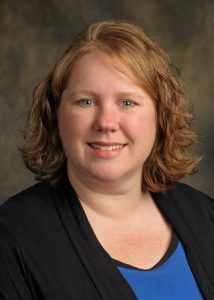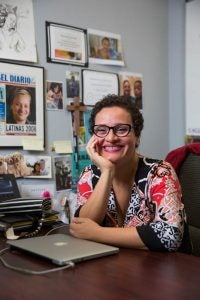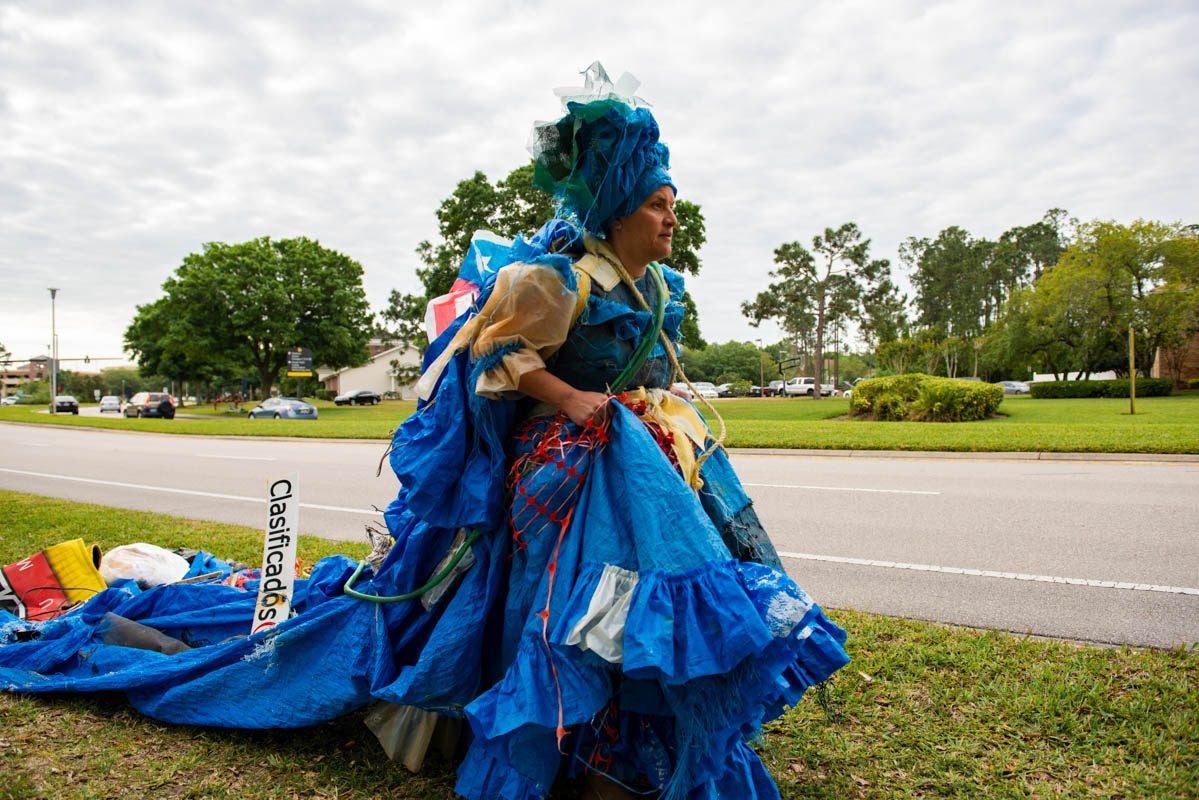Those who attended Associate Professor Wanda Raimundi-Ortiz’s Exodus/Pilgrimage performance during UCF Celebrates the Arts, were likely entertained and inspired by the Puerto Rican tribute — but it’s important to remember the artist intended for the experience to educate.
Raimundi-Ortiz lead a procession through downtown Orlando streets from the City Arts Factory to the Dr. Phillips Center for the Performing Arts in a gown made of debris collected from Puerto Rico after Hurricane Maria hit the island. Accompanying the performance artist on the mile-long journey was plena players performing traditional folkloric music with handheld drums. Once inside the center’s DeVos Family Room, Raimundi-Ortiz performed a dance to the beat of Afro-Puerto Rican bomba drummers.
An Inspired Message
“I’d been thinking a lot about how Puerto Rico is completely out of [mainstream] news,” Raimundi-Ortiz says about the inspiration for the performance. “My art is a social practice. It’s trying to pull from different places and create these opportunities of experiential learning. It’s not until you have people directly affected that you realize it’s far from over.”
Although Raimundi-Ortiz, a New York native of Puerto Rican descent, has family on the island — including an uncle who’s never left the island — she was hesitant to see her fears about living conditions there confirmed when she visited.
“My art is a social practice. It’s trying to pull from different places and create these opportunities of experiential learning.” – Wanda Raimundi-Ortiz, UCF professor
When Hurricane Maria pounded Puerto Rico in 2017 it caused an estimated $90 billion in damage and forced 130,000 people to migrate out of the country due to safety and living conditions. The island has only received $11.2 billion in recovery funds from the United States so far. Prior to the storm, children in Puerto Rico were three times more likely to face food insecurity than those in the United States. In March, 1.35 million people — more than one-third of the island’s population — had their food stamp benefits reduced by 35 to 40 percent because the Senate didn’t pass a disaster-funding bill
“It’s an island in the shadow of the United States. The hurricane only exacerbated that. Now almost two years later you have massive amounts of people who have moved to the United States just to survive,” Raimundi-Ortiz says.
Searching the Island

But in December, she faced her fears while visiting Puerto Rico to create the foundation of her performance. She was joined by Kristina Tollefson, an associate professor and costume designer in UCF’s theatre department. Aside from time spent researching and sketching, Tollefson spent about 50 hours constructing the traditional ruffle-style gown for Exodus/Pilgrimage. The two had worked together before on Raimundi-Ortiz’s Pieta performance in 2017, during which she acted as Michelangelo’s Mary and held 33 members of marginalized communities.
“We were looking for little bits of life [from] before the hurricane. It was surprising some of the things we found.” – Kristina Tollefson, UCF professor
“We were looking for little bits of life [from] before the hurricane. It was surprising some of the things we found,” Tollefson says. “Electricity was such a problem for so many for so long and continues to be, so we have electrical wires [to represent] that struggle of living without power.”
While searching the island’s natural lands they found blue FEMA tarps, one partially buried on a beach, the other on a mountaintop, that help make up the base of the dress and represent the storm’s broad reach. Raimundi-Ortiz says it was beautiful being in coastal towns, but it was devasting to see house after house as barren husks.
During three days they collected about 45 pounds of rain-soaked and sun-bleached children’s shoes and toys, signs from colmados (corner stores) and other items – the most surprising, Raimundi-Ortiz and Tollefson say, were sheets of salsa music. They were reminders of life and the importance of music to Puerto Ricans, another crucial element for the upcoming performance.
Referencing Cultural Traditions
“Before there was reggaetón, there was bomba, plena. … This is how we communicate. This is how we shared our stories.” – Wanda Raimundi-Ortiz, UCF professor
The idea for a procession as a start to the performance reflects the influence of Catholic and Christian religions on Caribbean culture for people to “take to the streets” like they do in carnival, Raimundi-Ortiz says. Plena music derived from working-class Puerto Ricans who use handheld instruments and singing to communicate about current events through a periodico cantado, or sung newspaper.
“It’s very much community activated. You have the person singing chants and another person comes back [with a chant] and the next person will call for next verse and the community will sing it back,” Raimundi-Ortiz says.
Once Raimundi-Ortiz is inside Dr. Phillips, she danced along to an all-female bomba drumming circle, a departure from tradition that dictates only men are allowed to touch the instruments. She wanted to utilize bomba, which is a call-and-response music and dance style, because it relates to the theme of forced migration and is rooted in Afro-Puerto Rican culture since African slaves created the music style as a form of communication.

“Not to disparage reggaetón, but that’s not the only representation of our people. Before there was reggaetón, there was bomba, plena. The roots, the base, the foundation of the Daddy Yankees, the Bad Bunnys [of the world], this is the core of it,” Raimundi-Ortiz says. “This is how we communicate. This is how we shared our stories. This is how we kept attached to our African roots. This is how we connected.”
Connecting to Common Roots
While thousands of Puerto Ricans are far from their homes and the ones still on the island are still struggling to piece their homeland back together, their strong spirit is a thread that ties them back to their roots.
“As much as this performance is about forced migration under duress, it’s about resilience,” Raimundi-Ortiz says. “My intention is not to have a broken back — to stand tall. There has been never-ending oppression for more than 500 years, and somehow our people are able to somehow figure it out — always. We come back, stand proud in the most difficult of situations. And there is a beauty in that kind of tragedy.”




